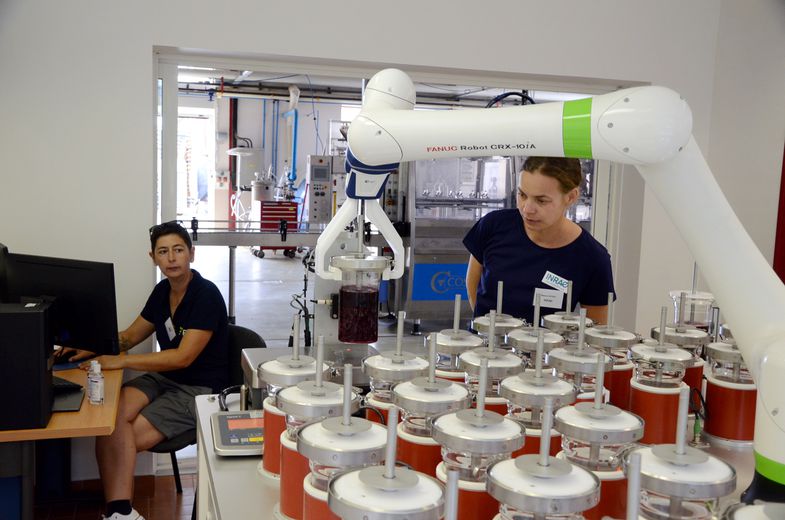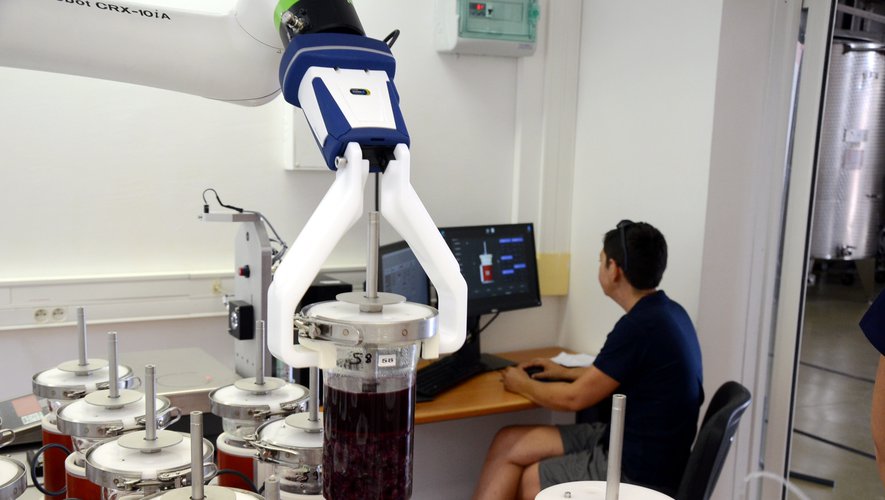Vinimag, a winemaking robot developed by IFV and INRAE, was introduced on Thursday. This cutting edge search tool is unique in the world.
Imagine a tool capable of accelerating the research to provide the sector with grapes resistant to disease and drought and capable of producing exceptional wines! Wine growers dream about it, and after 5 years of work, engineers from IFV and INRAE have successfully perfected a robot that works with double the effort: Vinimag. The entire IFV/INRAE research program represents €3.2 million over five years, including €400,000 in equipment.
A robot that works 24 hours a day
An articulated arm, conscientiously, brings in little tanks every minute for analysis. This robot was designed in partnership between INRAE and IFV in collaboration with manufacturers, including Narbonnais Socma.
“Since 1985, we’ve been watching fermentation online IFV Denis Capulet explains. INRAE has developed monitoring robots for white and rose fermentation, in the liquid phase. For reds, fermentation takes place in the presence of berries, which greatly complicates observation “.
The articulated arm of the robot picks up a small bowl of 1 kg every minute
So a tool has been developed to facilitate this research, which makes it possible to work with small tanks with a capacity of 1 kg, where small forms are easy to handle, freeze and store.
“We started from existing robots for eggs and roses, starting with our need for red, using drawings, imagining how to achieve our ends, and manufacturers solving the steps with us.” Denis Capulet explains. Thanks to its articulated arm, this robot grabs small tanks one by one every minute and places them on a scale. There, the weight and color are thoroughly examined, providing valuable information on the progress of fermentation and the extraction of polyphenols.
“You get fermentation data hour by hour, 24 hours a day, including holidays. You can also add yeast nutrients at the desired stage of winemaking. Denis Capulet who identifies adds: “Squeezing this heterogeneous phase of red grapes was a problem for us. So we had to devise a nano piston for each small tank. We did this in collaboration with Socma and saved a lot of time. Thanks to these small tanks, we have 1,200 potential test samples per year, which Significantly doubles our investigative capabilities. In test schemes, we have many different varieties, and this tool allows us to test more varieties at the same time”. A very important search accelerator, thanks to faster and more efficient results.

The articulated arm of the robot picks up a small bowl of 1 kg every minute
“interestExplains Nicholas Soren, director of the INRAE Pech Rouge Experimental Center in Gruissan. It is to accelerate the search for new resistant varieties. Because it takes about 8 years between the moment the variety is identified and registered in the catalog. With this bot we will ensure that this period is shortened by 6 years, thanks to the very early integration of oenology standards into the various selections. So as to develop the best resistance to both powdery mildew, and mildew, and drought, but that’s not all. Because you have to make very good wine. That’s the point.”
Thanks to its precious indicators, the robot will allow researchers to offer vine-growers resistant varieties with exceptional sensory qualities. An innovation that has been scrutinized throughout the wine world.

“Subtly charming problem solver. Extreme tv enthusiast. Web scholar. Evil beer expert. Music nerd. Food junkie.”

